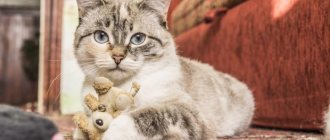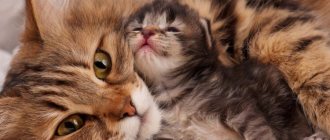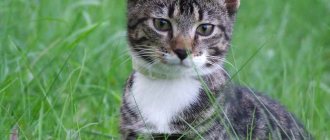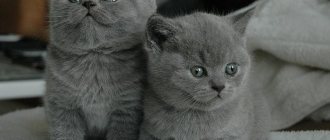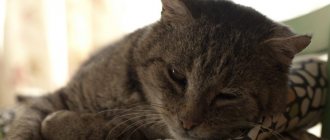This article describes what ailurophilia is.
There are many different attachments in the world, which we call diseases, and vice versa, there are illnesses that can simply be called a sick hobby or addiction to something. This can be said about ailurophilia. Many people still do not understand whether this pathology should be called a psychological deviation, or whether it is still a manifestation of an excessively good attitude towards animals. So what is ailurophilia - a disease or love for cats. Let's figure it out together in this article.
Why do people love cats
A soft, cozy creature that loves to curl up at the owner’s feet into a fluffy ball and emit a pleasant purr - a symbol of a warm, bright home, happiness, comfort and love. This is the main reason why people prefer to have mustachioed striped animals as pets. For many people, these animals are associated with peace and tranquility.
The way a person treats cats can tell a lot about his character. Psychologists have developed their own characteristics of people who cannot imagine their life without a furry purr:
- Women : They are often compared to cats, and for good reason. The fair sex, who loves cats, is just as graceful, well-groomed and full of mysterious secrets. She craves love, knows how and wants to give it back. But at the same time, she is independent and not always logical in her actions. Often women who do not have a family or children get cats to give them affection. At the same time, they know that in return they will receive boundless and selfless love. But there are pitfalls here. A cat, accustomed to receiving attention and affection, may have an extremely negative attitude towards the appearance of a man in the house.
- Children : a child who loves cats, gentle and affectionate. Most children are afraid of dogs, but are drawn to cats, and this happens at the level of instinct. This is explained by the fact that in a calm and cozy cat, babies see a reflection of their mother. In families with small children, psychologists recommend having cats. Such proximity makes kids flexible and calm, loving and responsible in the future. Contact with a cat helps alleviate stress for a baby who is weaning from breastfeeding.
- Men : if a representative of the stronger sex has a cat as a pet or has a weakness for cats, this indicates his soft and flexible character, his willingness to always seek compromises to make everyone comfortable and comfortable. Such men are less susceptible to stress, aggressive behavior and outbursts of irritability.
What kind of people are they who don’t like cats? There are also those who cannot stand purring. But in most cases, the reason lies in the subconscious, the presence of psychological problems:
- A woman who does not like cats does not perceive, does not realize, and even denies her feminine nature.
- Most men are misogynists. Men with non-traditional sexual orientation are not particularly fond of cats, but this is not a mandatory rule, but rather an observation.
Cats don't have to be liked by everyone; some people simply prefer other animals, finding them cuter. But if a person hates cats, there is an explanation for this in the form of a number of psychological reasons.
Ailurophilia test: questions and answers
Do you have an excessive love for cats? Can't imagine life without your pet? Do you think that you have ailurophilia, since you love all the cats around without exception? Take the test to find out if this is really true. Below is an ailurophilia test with questions. Answer “yes” or “no” , write down the result:
Ailurophilia test Ailurophilia test Ailurophilia test
If you have more “no” , then you don’t have to worry - you don’t have illness or excessive attachment to cats. If you have equal numbers of both answers, then you should think about your love for these animals. More “yes” already indicate a tendency to the disease.
Be careful and dig deep within yourself, asking yourself what exactly motivates you. If other people around you already notice such a sick attachment, then you should consult a doctor for help so that the disease does not progress. Good luck!
Psychology of cats - features
Everyone knows that cats are independent.
To understand how much, you can pay attention to the scientific fact: dogs “get infected” by yawning from people, but cats never repeat it after a person.
Considering the fact that repeating a yawn after someone is related to such a feeling as empathy, this perfectly explains the psychology and attitude of cats towards humans.
If you want to get a kitten, it is recommended to take into account the peculiarities of the psychology of these animals:
- Cats openly express their attitude towards humans, and not only in general, but also at a certain moment . You can often see this behavior from a pet - the cat lies on its back, clasps the owner’s leg with its front paws, and begins to make intense movements with its hind paws, similar to beating. At the moment, the pet is actually hitting the person, and not playing with him. The animal beats with its front paws - it shows its reluctance to communicate, trying to show the person that he needs to leave.
- Games . Cats are designed in such a way that they do not perceive uniform movements for a long time, simply cutting them off. This is why many owners are perplexed why their pets do not want to play with a new toy, quickly losing interest in it. If you make impetuous movements with the toy, impulsively waving it and periodically pausing, Murka will be delighted with such a game. And evenly waving, like a fan, will lead to the fact that after 30 seconds the cat will stop perceiving the object and will look through it.
- You can train a cat . The only paradox is that this takes too much time, during which a person, without realizing it, will be raised by his pet.
- For a cat, the owner is not the one who feeds him and cleans the litter box . The owner is the one who took the kitten in his arms after the mother, who raises it, even if this is punishment for pranks. And the one who feeds is just a “feeder”.
Having trouble raising a cat? It's not about her mental abilities, but about her approach to this issue. To raise a cat, you should act consistently and not rush. If an animal decides that the manipulations that a person performs with it are just nagging and a manifestation of the owner’s bad mood, it will continue to do its dirty tricks. Or it may react differently: take offense at the owner and deliberately commit unpleasant pranks.
Features of behavior:
- There is an opinion that certain breeds have a tendency towards aggression. It is not true. The pet’s malicious behavior and tendency to do “bad things” are only the result of a lack of proper attention and education, which spoils the animal’s character. With equal probability, notes of aggression in behavior can be observed in an active Siamese cat that is not properly handled, and in a British cat, endowed with a phlegmatic disposition by nature, but by chance finds himself in a family with noisy and overly active household members.
- Cats don't like dogs - not because they see them as competitors or are afraid of being their prey. This hostility is explained by the peculiarities of cats’ perception. They do not like sudden movements (unless they are made by potential prey). If a dog runs around a cat, it will not understand what they want from it - to eat or play. The result of such encounters is the same - in case of close contact, the dog will receive claws on the nose as a precaution.
- Rumbling in cats is a sign not only of complete relaxation and pleasure, but also a way to attract attention. And if the animal does not immediately get what it wants, the rumbling intensifies. If we draw an analogy, it is comparable to the human “ahem.”
- Cats are extremely rarely able to remember a specific person. At the same time, their associative connections are configured in an amazing way. For example, a cat will consider all men to be veterinarians if one was a doctor with whom he had previously been in contact. Cats also have associations based on smell. If a scented guest cuddled and caressed a cat, she will henceforth associate this smell with tenderness and attention to herself.
- When purchasing a kitten, the owner may rack his brain for a long time over a suitable nickname, while assuming that cats are unlikely to remember and understand their names. In fact, cats remember nicknames very well, however... they don’t always respond to them. When the owner calls the cat by name, she wonders whether she should go, whether she will get something pleasant in return, or whether it is better to continue to lie lazily and mind her own business. In most cases, the second option wins.
Good moms
Many people are accustomed to thinking that any cat has an incredibly developed maternal instinct, which it shows not only in relation to its kittens, but also to human cubs. It is not always so. There are cats that don’t particularly care for their offspring, caring for and raising kittens only because no one else will do it for her.
There is also the opposite situation - a cat who is a supermom. She is really ready to babysit not only her own kittens, even if they are already adults, but also strangers, not allowing their own mother near them. Cats are amazing and completely unpredictable animals that do not always fit into certain behavioral patterns.
Persian cat
- Weight: 3.2-5.5 kg
- Life expectancy: 10-17 years
- Breed type: longhair
Persian cats are known for their docile and gentle nature. These pets are cute and funny. They are also called "couch" cats . But sometimes they are very playful, curious and quite active, so don't be surprised if you spot them sitting on a tabletop or hanging from curtains. These felines are happiest and most relaxed when in the company of their owner. Your dog will most likely be eagerly waiting for you to quickly jump on your lap and cuddle to his heart's content.
Persian cats are one of the most ancient and popular breeds on the planet. At the moment, there are almost 100 varieties of Persians by color.
The Persian cat is best kept indoors, and there are several reasons for this. Firstly, their hair must be in perfect shape, without regular brushing it will become tangled. Secondly, these cats are naturally shy , and they can be very scared outside the home. These are not the breeds that will explore unfamiliar territory and look for a reason to fight with their relatives. However, they will seek out their people and strive to be close to them. This is a pampered feline that feels happy when you pamper it.
Man - friend or feeding slave
Even the most affectionate, sweet and gentle pet can at any moment wag its tail and leave a person, stopping communication with him for a while.
Unlike devoted dogs, who are ready to follow their owner everywhere with inexhaustible love, cats prefer to maintain independence and a bit of disdain in their relationships with humans.
Features of the relationship between cats and people:
- According to the research of anthrozoologist John Bradshaw, the cat perceives a person as a “brother-in-law,” only a very large and safe one.
- The owner’s “lisping” with the cat, “intimate” conversations with him or addressing him as a small child, and not as an animal - all this is a desire to endow a cute pet with qualities characteristic of a person.
- Although cats have been kept as pets by people for a long time, they are not as close to their owners as dogs. This is due to the peculiarities of the period of their domestication. When taming dogs, a person communicated with him on equal terms, because the task was to make the dog understand them. With cats it's a different story. A person needed them to protect his house from mice. Cats lived next to people, but at the same time they existed as if in a parallel world.
- For the mustachioed and striped people, man is not the center of the world. No matter how gentle and affectionate a pet may be, you should not expect bright manifestations of feelings and the same reciprocal love from him. Cats live their own lives, occasionally allowing close contact with people, and only when they want it.
- When a cat brings a caught mouse into the house, many owners are touched, believing that the pet wants to share a meal with them. However, the purr is not capable of such “generous” actions. He simply brought his prey to a quiet place where no one would lay claim to it.
- The cat demonstrates its disposition towards the person and the desire to receive affection and attention from him accordingly - he begins to rub against the owner’s legs and expose his head, tilting it to the side, so that he can be scratched behind the ear. The cat will behave the same way towards its fellow tribesmen.
When placing high hopes on your pet, expecting absolute obedience and good behavior from him, you should remember that a person is not the cat’s owner, but only his big “neighbor” who feeds and cares for him.
Does ailurophilia go away over time?
Ailurophilia
If a person lives nearby who causes a lot of problems, then you always want to know when all this will go away for him, and whether he will understand that it is difficult to live next to him. So the question arises: does ailurophilia go away over time?
For this pathology to go away faster, a person should be treated by a psychiatrist or psychotherapist. The doctor will be able to find the true cause and prescribe medications to help the nervous system and brain. Without medical help, such a psychological disorder can last for years in a person.
Interesting facts about the psychology and behavior of cats
Cats are unique creatures, but sometimes people find their behavior strange and funny:
- Each cat has his own preferences regarding the appearance of the female. One male may be completely indifferent when he sees a tortoiseshell or red cat near him, and show intense interest when he meets a black cat.
- Many cats at shows get very nervous because of the large number of people and unfamiliar surroundings. These nerves manifest themselves in constant tail twitching. This is easy to deal with - the owner pinches the tip of the tail with his fingers, returning it to a static position, and the cat immediately calms down. The effect is triggered - there is no opportunity to show your nervousness - which means there is no nervousness itself.
- Cats have a sense of humor, but a “peculiar” one. Their favorite pastime is to quietly get close to another cat and scare him with his sudden appearance.
Europe
In the Middle Ages, European cats were persecuted: then it was believed that the cat was a reincarnated witch. Perhaps this is why cats are now best protected by law in Europe.
A cat in Europe is endowed with rights no less than those of a human. There are no stray cats here at all: if a cat is kicked out of the house, the owner is subject to a hefty fine. Each pet is microchipped, so a lost cat can be found very quickly.
To get a cat in Europe, you need to prove that the future owner has a good place to live and money to feed the pet. You will also have to indicate the composition and lifestyle of the family: it is important for officials to know that the cat will not be harmed.
In Austria, for example, cats are allowed and even then receive a pension: they will pay in meat and milk. In Germany there is a Cat Museum, which also employs cats and presents several thousand exhibits to visitors.
Belgium hosts the Kattenstut cat festival with performances and spectacular shows. The holiday is scheduled on the second Sunday of May every three years.
We wish all cats to be respected and loved!
Did you like the article? Share with your friends!
Cat tongue or how to understand a pet
Considering the peculiar and extremely capricious nature of cats, it is quite possible to make life with them comfortable for both parties if you learn to understand pets, recognizing their mood and desire by certain postures and sounds made:
- Hisses - warns that he doesn’t like how they treat him (read more about why cats hiss).
- Snorting - wants to divert attention from himself, in the same way he can express confusion and surprise.
- Grumbles - shows an extreme degree of dissatisfaction.
- Rumbling in a low range - ready for his own defense, which means he is extremely wary of the current situation.
- “Meow,” said briefly, is a greeting.
- Smacks his lips or clicks his teeth - he shows the instinct of a hunter, but at the same time he shows irritation that he was unable to catch the prey.
- He purrs - he is absolutely satisfied with his position.
- “Meow”, played with a slight hoarseness, shows gratitude and good attitude.
Poses and their explanation:
- Sits, covering his paws with his tail - complete moral and physical relaxation, absolute calm. In this position, it can watch with interest its owner or what is happening outside the window.
- Shifts from paw to paw, rubs against a person’s legs - this is how a pet greets its household members.
- Rubbing its head against a person’s legs or his face shows openness and complete disposition towards the owner.
- The back arches - it’s scary.
- The fur stands on end, the paws straighten sharply, the body is raised high - it feels threatened.
- Lying with his stomach up is a posture of thoughtfulness, dozing.
- The tail is raised up - the animal is calm and friendly.
- A ruffled and drooping tail is an expression of complete confusion.
- The tail hanging down and tapping it on the floor is a sign of fear.
- It intensively wags its tail in different directions, the tip touches its paws - it is in an extreme state of irritability and can behave aggressively at any moment.
What the eyes will tell you. You can also understand a cat’s mood by the expression in its eyes:
- Eyelids are half-closed - relaxation, a feeling of peace and absolute calm.
- Eyes wide open - a manifestation of incredible interest.
- The pupils are greatly dilated - fear and fright.
- Looking away to the side - she is ready to obey and do what her owner wants from her.
- Looks into a person's eyes, ears directed forward - interest, desire to communicate or receive a treat.
Knowing how a cat shows emotions, you can predict its desires and needs, assess your pet’s readiness to make contact or its desire to be alone.
Asian countries
Cats living in Korea, Vietnam and the Chinese province of Guangdong are out of luck: here it is not considered shameful to eat cat meat.
This barbarity is due to the fact that the inhabitants of these countries do not see any benefit from cats. In addition, there is no cost involved in growing such food.
The Japanese have a completely different attitude towards cats: they simply adore fluffy cats! The country has many stores with goods and accessories for cats, and when planning a new home, the Japanese immediately think about the convenience of their cats. Space is allocated for cat play areas and a claw-resistant finish is selected.
It was Japan that came up with the cat cafe: a place where you can come to drink coffee and chat with cats. Only in this country there is a cat temple: it was built in honor of seven cats, by whose eyes Japanese warriors determined time.
Maine Coon
The gentle giant Maine Coon is the largest of all domestic cat breeds and has a heart as big as he is! These cats, with their long, silky coats, rank high on the list of friendliest breeds. The Maine Coon loves everyone around him - from children to other pets. Loves long, quiet hugs and restless games. He will often rub his head against you and follow the shadows of those people he loves, making it clear how dear and important they are to him! Maine Coons love to sit on your lap, sleep on your bed, be present at your table and live in your heart!
Abyssinian cat
- Weight: 4.1-7.7 kg
- Life expectancy: 15 years
- Breed type: shorthair
This is a very sociable, active and people-oriented cat. The Abyssinian cat is an excellent climber , and she is also incredibly inquisitive. And if she sees something that piques her immediate interest, she won't be afraid to explore the new object.
Abyssinian cats are sometimes called "Aby-grabbys" because they tend to grab things that attract their attention.
Interestingly, Abyssinian cats are usually divided into two different categories - racers and lazy ones. This is due to the fact that representatives of this breed can be very playful or incredibly calm and balanced. Either way, they love people and are very friendly.
But keep in mind that Abyssinian cats do not tolerate loneliness or alienation well. They crave attention and are not shy about demanding it when they see fit. The Abyssinian cat also ranks high on many lists of the smartest cat breeds !
Countries where cats are revered and protected
A reverent attitude towards our smaller brothers has been preserved in the following countries of the world:
Japan.
The only place where there is a temple for four-legged furry pets. In addition, the land of the rising sun even celebrates a holiday - Cat Day. It takes place on February 22. On this day, many owners and their pets gather in the main square and have fun. In Japan, there are special coffee shops where you can come and play with cats, feed them, or just watch the games.
The homes of Japanese residents have special pet towers, and during the construction phase they choose the finishing that will be used in the house. Repairs in the rooms are made with special materials that are resistant to cat claws.
Islamic states.
The great Prophet Muezze had a cat, which he treated with the greatest respect, never bothered her when she was sleeping, and took her water from a bowl for prayer. For the prophet, four-legged pets were free animals, which is why he forbade their sale, exchange for goods, or extermination. Currently, many Muslims respect their mustachioed brothers, believing that cats can tell the great prophet about their attitude towards her.
Europe (Germany, Denmark, Norway, Czech Republic, England, Belgium).
In these countries, it is quite rare to see a stray animal on the street. If a cat is found on the street, it is taken to a shelter and the owner’s name is found out - every pet has a built-in chip. If the owner for some reason cannot care for the cat, it is assigned to a new family. It is worth noting that in European countries all animals living at home are protected by law. Owners who abuse their pets will have to pay a large fine. That is why, before getting a four-legged friend, Europeans need to collect a lot of documents and sign an agreement that details all the conditions for keeping a cat.
Greece.
A heavenly place for mustachioed friends. The Greeks prefer to keep cats and kittens outside, actively feeding them. The weather in the country is conducive to outdoor life, so the animals do not suffer at all; on the contrary, they enjoy an abundance of food and look well-fed and healthy.
Italy.
Cats in Rome are considered saviors. At the beginning of the last century, the passages at the Torre excavations were disrupted, as a result of which mice and rats were able to come to the surface and quickly settled in neighboring houses. Troops of cats were sent to help city residents. The rodents, sensing the cat's smell, quickly ran away. And the mustachioed defenders remained to live in the excavations in the crevices. City authorities began to feed homeless animals and even recognized them as part of history.
Italy also celebrates Black Cat Day - this holiday was adopted in honor of the unjust extermination of four-legged pets during the Great Inquisition. On this day, Italians organize picnics, parades, parties and actively glorify black cats and their owners.
Scottish fold cat
- Weight: 5.9-7.3 kg
- Life expectancy: 11-15 years
- Breed type: shorthair
As soon as you see a Scottish Fold cat, your heart will melt. Her small folded ears and unique ability to sit on her hind legs, bent at the belly, attract attention at first sight. The friendly nature of the Scottish Fold cat will make any person squeal with joy from cuteness overload.
Curled forward and downward ears, resulting from a natural mutation of genes, give the Scottish Fold an “owl-like” .
Scottish Fold cats love to interact with people. In fact, many Scottish Fold owners joke that their pets don't even realize they're not human. As long as you support their routine, you will have a unique, strong bond with your feline friend.
Ailurophilia: how love for cats turns a person into a slave
In ancient times, people idolized cats: these graceful animals protected supplies from mice and gave their owners peace and tranquility, and some even believed that they were endowed with magical powers. Today cats are one of the most popular pets. They also conquered the Internet. But this “cuteness” also has a dark side. This is ailurophilia - a pathological attachment to cats. The RIAMO in Balashikha correspondent tried to understand the “cat disease”, its causes and symptoms.
Mental disorder
The word "ailurophilia" comes from the Greek "ailuros" - "cat" and "philos" - "love". These words evoke pleasant thoughts about tenderness and affection, but in reality everything is not so rosy. Ailurophilia is a recognized mental personality disorder.
“Let’s immediately make a reservation that we should not confuse people with a pathological mental disorder and those who simply love animals very much, but within reason. There are a lot of memes about cat people floating around the internet. For example, a picture: a human skeleton is sitting in a chair, and a cat is sleeping in his arms. The message is this: the owner is “withered”, but does not disturb the sleep of his beloved pet. Cat people treat themselves with humor, and this is one of the signs that they are of sound mind,” says psychologist Maryana Nabigulaeva.
“Here is the most typical picture of ailurophilia: a person lives in a two-room apartment with 20 cats. There is total unsanitary conditions, and all the neighbors suffer from the terrible smell. The animals suffer from overcrowding and hunger - the owner is unable to feed them. A person either does not react to any complaints or claims or takes them with hostility, fiercely defending his animals,” explains the psychologist.
Sometimes people suffering from ailurophilia do truly shocking things. There are many known cases where cat lovers kept the corpses of their pets on the balcony, being unable to say goodbye to them. Others froze animals in the freezer and said that they wanted to prolong their life in this way - “after all, a cat can be thawed in 10-15 years and revived.”
Causes of the disease
Statistics say that people suffering from ailurophilia are united by loneliness, emotional instability, social isolation and low self-esteem. Single elderly women are especially susceptible to the disease, although in recent years young people, including men, have also begun to be affected.
“Typically, ailurophilia is closely associated with another mental illness, such as schizophrenia or dementia. Often, a pathological love for cats arises after some serious mental trauma - the loss of a child, the death of relatives, the betrayal of loved ones. In each of these cases, cats play their role: either they fill the inner emptiness and brighten up a person’s loneliness, or they give a feeling of their own superiority over other, albeit weak, creatures,” explains Maryana Nabigulaeva.
New hypothesis
In 2011, American scientists shared with the world a new hypothesis about why cats so easily “enslaved” humanity. It turned out that the Toxoplasma gondii parasites, which can be contained in cat feces, can disrupt the functioning of the human higher nervous system and cause various behavioral abnormalities in him, including a pathological love for cats.
This discovery was discussed for a long time in the scientific world, but in the end scientists came to the conclusion that Toxoplasma gondii can indeed “awaken” an uncontrollable love for cats in a person, but in very rare cases. Toxoplasmosis is also associated with the development of schizophrenia.
What to do?
Society certainly suffers from people with ailurophilia. Neighbors complain about the terrible smell emanating from the “bad apartment”, the constant noise and cat squabbles. Call the local police officer? He will just shrug his shoulders, because the owner of 20 cats cannot be charged - he has not broken the law.
Environmentalists and social activists supported the initiative: some with concern for animals, others with concern for neighbors who suffer from overzealous cat and dog lovers. Unfortunately, the law has not yet been adopted.
“A person suffering from any mental disorder simply does not accept the fact of his illness. And ailurophilia is no exception. It is useless to appeal to reason or openly conflict. If concerned neighbors want to help, you need to get in touch with the relatives of the cat owner. Perhaps they live in another city and have no idea of the scale of the problem. If you have no relatives, you need to go to a clinic or a neuropsychiatric dispensary together with the local police officer. Unfortunately, you are unlikely to help a person with ailurophilia in other ways,” sums up the psychologist.
Ailurophilia: causes of the disease
According to Western scientists, 46% of people with ailurophilia are single women, most often elderly. But among pathological cat lovers there are also quite young people of both sexes. Introverts and those who have experienced severe psychological trauma, such as losing their loved ones, are often susceptible to mental disorder.
Treatment of this disease is the task of specialists in the field of clinical psychology and psychiatry, because ailurophilia often coexists with dementia, schizophrenia or bestiality.
According to the observations of doctors, people who share similar personality traits are at risk: low or unstable self-esteem, emotional instability, lack of meaningful and reliable social contacts. In this case, cats not only fill the spiritual emptiness, but also give the sick person the opportunity to feel his own superiority - after all, there are living beings nearby who depend on him.
At the same time, a number of studies show that loving cats in itself does not increase the risk of mental disorders. In 2011, French scientists conducted a broad analysis of data from 37 countries and found that cat owners are no more likely to have mental disorders than those who have never owned cats. In 2012, observations of 600 thousand older people were carried out in the UK - the conclusion was the same.
Is toxoplasmosis to blame?
Recently, scientific publications showing the relationship between infection with toxoplasmosis and the development of mental illness have become more frequent. For example, parasitologists from Stanford University in the USA found that Toxoplasma gondi, entering the cerebellar amygdala, which is responsible for positive and negative emotions, causes a living creature to change a set of conditioned reactions.
Parasites can have a similar effect on a person, causing him certain deviations in behavior, including those when he turns his home into a kind of animal den, forgetting about his own comfort and hygiene, not to mention the people around him.
Indeed, the causative agent of toxoplasmosis is one of the few parasites that can overcome the blood-brain barrier and, once in the brain, disrupt its functioning, but it is still not the only one. Disturbances of higher nervous activity can also be caused by echinococcosis and toxocariasis, and it is much easier to become infected with them.
Thus, cats, or rather, contact with their feces, can cause the disease with toxoplasmosis, but this way is far from the only one, and even more so, not all people develop a painful love for cats or other mental disorders against the background of toxoplasmosis.
How to treat ailurophilia
Only a qualified specialist can determine how to treat ailurophilia, and finally make such a diagnosis. Or rather, even a council of doctors - clinical psychology and psychiatry in this case closely interacts with other branches of medicine. Treatment methods are determined by the doctor individually for a particular patient.
As with all mental disorders that develop gradually, a person does not realize that he is sick and often refuses to be treated, and therefore urgently needs the help of loved ones or people he simply knows who will convince him to see a doctor.
If such a person is in your environment - lives next door or works in the same team, it is very important to show attention, simple human participation, which will relieve him of the feeling of loneliness or misunderstanding. Before the so-called “point of no return,” the disease goes through several stages, when the patient can still be helped
If the disease has already reached a serious stage and a person has ceased to hear reasonable arguments, one should contact a psychoneurological dispensary at the place of residence, where qualified specialists work who can find an approach to the patient and convince him to begin treatment.
The cats of such owners will certainly be better off in shelters or foster care with good volunteers. At least there they will receive normal care and the prospect of finding new, adequate owners.
Indifference or pseudo-sympathy (why touch grandma? And I feel sorry for cats!) in the case of ailurophilia, as with any other mental disorder, is very dangerous. After all, this disease has nothing to do with real love for cats - it is destructive for animals, perhaps even more than for the patient. Look around - maybe there are living beings nearby right now, humans and cats, who need your help.
Ailurophilia (gatophilia, galeophilia) is a mental disorder of a person suffering from pathological, uncontrollable attachment and immense love for cats. Often, painful attachment is observed in elderly and lonely women who have no one else to care for. With this disorder, people can simultaneously keep up to several dozen cats, without being able to provide them with acceptable living conditions. The cat family helps to cope well with loneliness, filling the house with its presence and replacing departed loved ones. In most cases, ailurophilia is observed in individuals who find it difficult to get along with other people. The mass keeping of cats creates a lot of inconvenience for other residents of the house due to the violation of silence and sanitary rules.
Ailurophilia can manifest itself not only in older people, but also in young people, both women and men. Lonely or isolated people who have lost their loved ones, or people who are sexually attracted to cats are at risk.
Burmese cat
- Weight: 2.8-6.8 kg
- Life expectancy: 14 years
- Breed type: longhair
The Burmese cat is one of the most beloved cat breeds all over the world. As the name suggests, this breed originates from Myanmar , formerly known as Burma. With blue eyes, color-point fur and white paws, Burmese cats look absolutely stunning, and they have the right personality.
Burmese cats are a great example of how dog-like some felines can be. If treated properly, they will become loyal companions, extremely attached to their owner.
Owners of these cats often report that they have an innate desire to always be close to them. The flexible nature makes the Burmese cat an ideal option for owners who have several pets at once. Regardless of whether you have other cats or dogs, the Burmese cat is likely to make friends with them, wanting to turn them into playmates. Their indisputable advantage will be their relative silence . And when they speak, their voices sound a little hoarse and muffled.
Regdol
One of the friendliest cats is the fluffy ragdoll, a fairly new breed developed in the 1960s. The ragdoll (English: “rag doll”) got its fancy name because it completely relaxes in the hands of its loved ones and its limp body is pleasant to hold on your lap or carry around the house like a child.
Ragdol is a good choice for people who live in apartments or other small spaces; it gets along well with children. Rag Dolls are affectionate, bond with family members, and are always greeted at the front door when returning home. They are a little aloof, not particularly curious, prefer to follow their owners around the house, ready at any moment for a sudden kiss or an unexpected hug.
